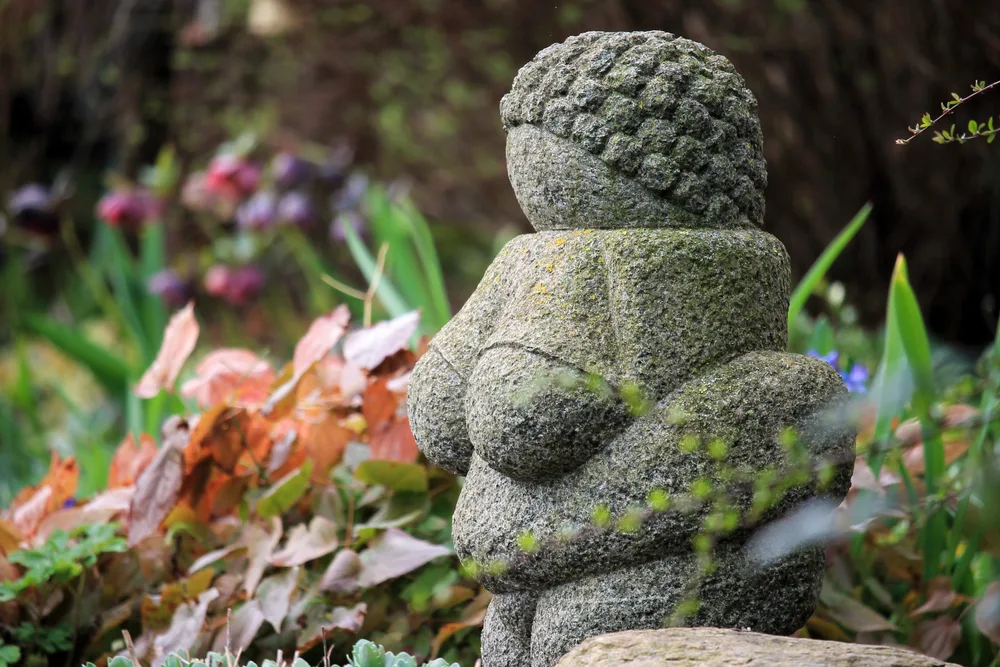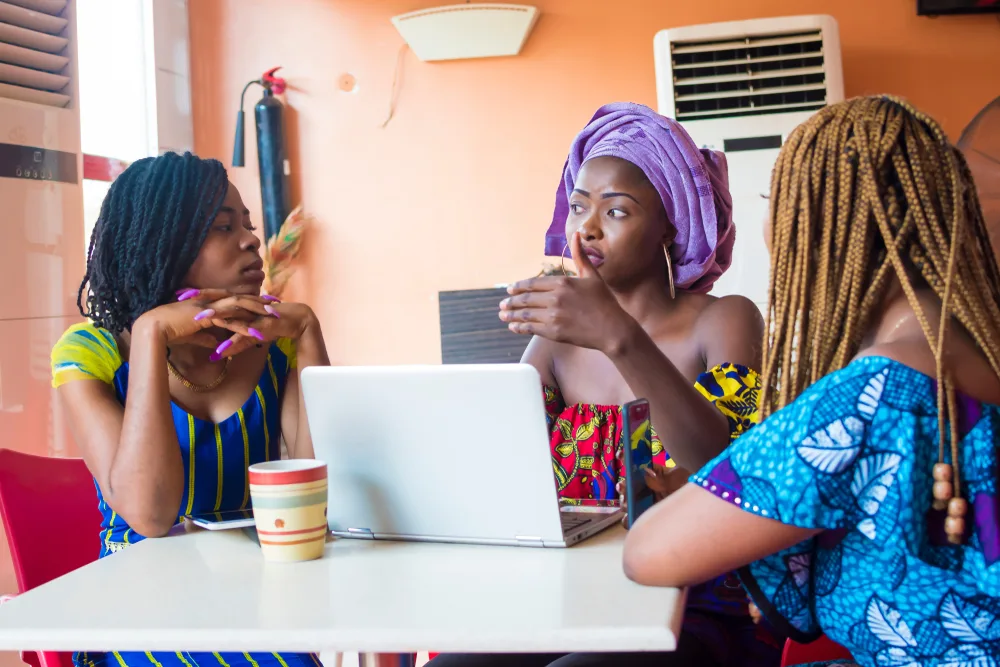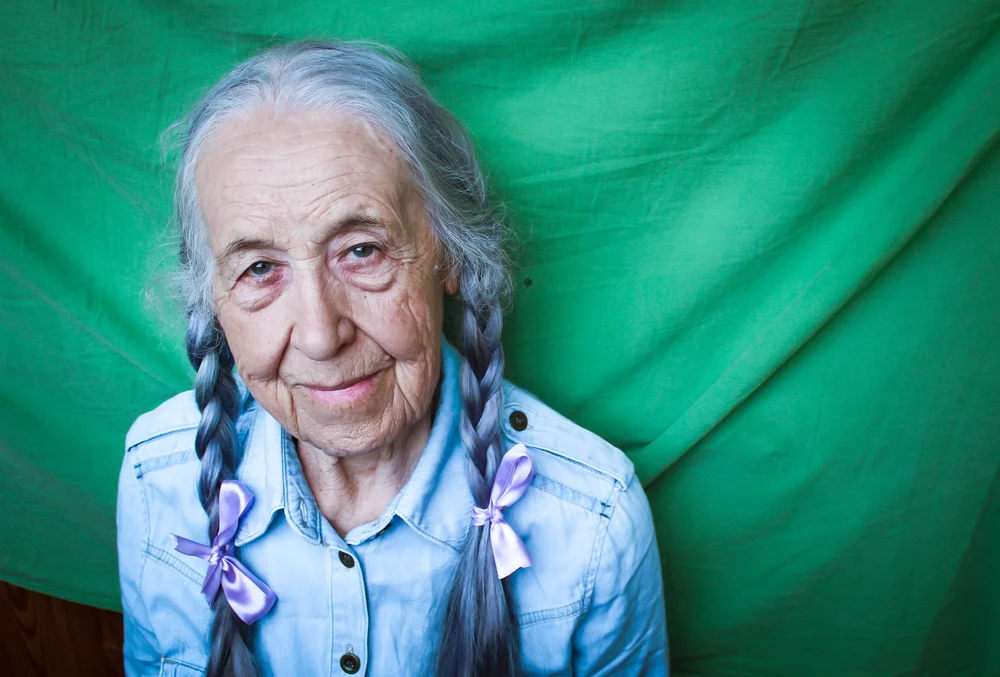Jump to:
Who created braids? Have you ever wondered which culture claims the origin of braided hair? This article will take a historical dive into this hotly debated topic.
The Origin of Braided Hair
Braided hair is a cultural staple in many societies around the world. To truly learn about the origin of braids, we’ll go step-by-step into each culture historically associated with braided hair. To summarize, the origins of braids can be traced to one of the following cultures:
- The Venus of Willendorf
- Himba People of Namibia
- Historical Braids in Europe
- Historical Braids in Africa
- Historical Braids in Asia
- Historical Braids in the Americas
We’ll dive into braids’ origins and their cultural significance for multiple cultures. We’ll also discuss various types of braids, practical uses, and modern-day conversation surrounding braids.
1. The Venus of Willendorf

Helsingborg, Sweden – April 8 2019: A statue of ”Venus from Willendorf” in a swedish garden in the spring blooming/Richard Rinaldo/Shutterstock
The Venus of Willendorf is the oldest known artifact depicting braids, estimated to date back to 28,000 to 25,000 BCE. This artifact was discovered in Austria, along with other human figurines.
While the Venus of Willendorf is the oldest known piece of archeology that shows braids, scientists can’t conclude Austria as the birthplace of braided hair. However, we can be sure humans have been braiding hair since at least the Paleolithic Period!
2. The Himba People of Namibia
Some have credited the Himba people of Namibia as the original braiders. Braiding hair has deep roots in the Himba culture, and they have been perfecting their craft for centuries.
Known for their elaborate red, matted braids, their unique hairstyle offers a peek into their rich tradition. The traditional look is accomplished by mixing animal fat, local stones, and ash into the hair.
3. Historical Braids in Europe
Both men and women wore braids in the Celtic culture. Many other cultures at the time viewed this practice as strange or barbaric. There is evidence women wore elaborate braided hairstyles, sometimes involving intricate knots, ribbons, and jewelry.
4. Historical Braids in Africa

i_am_zews/Shutterstock
Braiding hair has a rich cultural significance in a variety of tribes and cultures in Africa. For example, dreadlocks have been found on ancient Egyptian mummies. Box braids were viewed as a status of wealth and power and can be dated back to 3500 BC in societies living in South Africa.
Fulani braids can be traced back to the Sahel region in West Africa. Ghana braids can be seen in art dating back to 500 BC, and cornrow braids can be dated around 3000 BC to the Sahara region of Africa.
5. Historical Braids in Asia
In ancient India, the ancient Hindu scripture known as The Vedas references the Hindu God Shiva as wearing jata or a dreadlock hairstyle. The jata hairstyle dates back to 1500 BC. In ancient China, unmarried girls and women typically wore simple braided hairstyles to represent their single status.
This was an important aspect of ji-li, a coming-of-age ritual involving unbraiding and brushing hair. The hair was eventually pinned and became a status that she had reached womanhood.
6. Historical Braids in the Americas

Iva Mariia/Shutterstock
Almost every Native American tribe in North America incorporated braids into their culture. For example, the Kiowa tribe was known to incorporate furs into their braiding. Kiowa men wore two long braids wrapped in fur. In 16th century Columbia, braids were used by Afro-Columbian to relay messages.
A thick, tightly braided hairstyle known as departes signaled the intention of escape. Braids curved to the scalp were used as visuals to represent which roads were planned used to travel for escape.
Modern Day Types of Braids
Today, braids are worn by various people in a wide variety of cultures. Knotless braiding has become very popular in the black community. It involves braiding an inch or two of natural hair into synthetic hair.
The result is a lighter, easier-to-manage hairstyle. French braids remain a popular hairstyle for various ethnicities, although the origin may not be as simple as the name suggests.
The style is typically attributed to either Greek or African culture, despite the name. The oldest known artifact depicting a French braid was found in Algeria and is thought to be 6,000 years old.
Read Next: 30 Unique Types of Braids for 2025
Practical Uses for Braided Hair
As we’ve learned, many ancient cultures incorporated braids into their society. Which society first invented the braid is unknown and can be a hotly debated topic. However, we can explore the practical uses of braided hair in culture.
First, we’ll discuss the social benefits of braiding. Braiding is often time-consuming and used in many cultures as a time to bond, tell stories, and get to know one another.
Braids were also used to keep hair appearing neat and out of the face. In medieval times, uncovered hair was considered inappropriate for women. As a result, braids were an easy way to tuck hair under a scarf.
Conversations Around Cultural Appropriation
Although braids can be traced to many different cultures, they are perhaps most strongly associated with African cultures. Therefore, cultural appropriation questions create essential conversations around what is ethical, appropriate, and considerate regarding hairstyles.
While social scientists still can’t nail down the origin of braids, it’s worth discussing why Allen Iverson was called a “thug” when he was the first to debut cornrows in the NBA. Yet, Kylie Jenner is celebrated as a fashion icon for wearing the same hairstyle to a music festival.
Frequently Asked Questions

Look Studio/Shutterstock
Still, have more questions about who created braids? Never fear; we’ve compiled some frequently asked questions to answer all you need to know about the origin of braids.
Why don’t we know which culture created braids?
Unfortunately, scientists can only go back as far as the artifacts. Because braiding is such an ancient and universal concept, few pieces depicting braids from thousands of years ago still exist. In addition, just because the oldest artifact is attributed to Austria doesn’t mean an older artifact in Egypt doesn’t exist. It just hasn’t been found.
Do braids belong to one culture?
Braids exist in cultures across every continent that humans inhabit. While braids may hold more significance to one culture over another, braided hair does not belong to just one culture.
Why are braids cultural?
The cultural impact of braids depends on the specific society. In some African cultures, for example, braids symbolize wealth, marital status, age, religion, and tribe affiliation.
Is it cultural appropriation for white people to braid their hair?
Cultural appropriation is a heavily debated topic discussed in many forums online. We invite you to consider the type of braid used, the intention behind the braid, and the cultural history of that particular braid. In short, there is no universal answer here.
Are plaits and braids the same thing?
Typically, you can use these two words interchangeably. Both words mean to interweave the hair in a specific pattern. However, they can have slight variations in some parts of the world.
So, Who Created Braids?
As we’ve proven above, many cultures have strong ties to braiding traditions. Unfortunately, due to the limitations of history and archeology, we can’t determine one true origin of the braided hairstyle.
So instead, it’s important to celebrate the unique history and purpose each culture has related to braids. And while you’re here, be sure to head over to our “inspiration” section to find other unique ways to style your hair!
